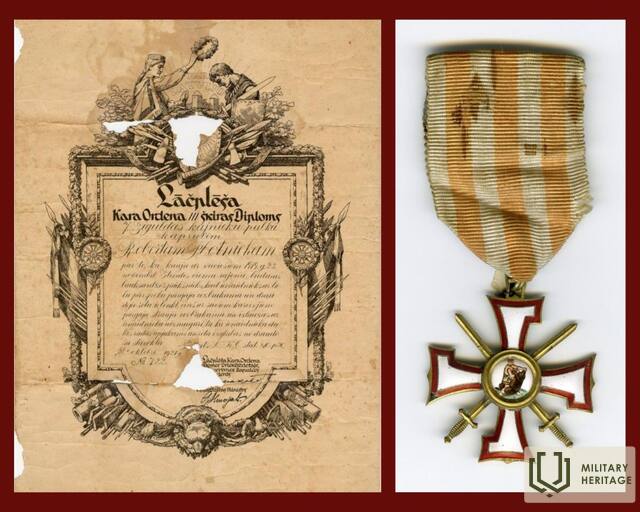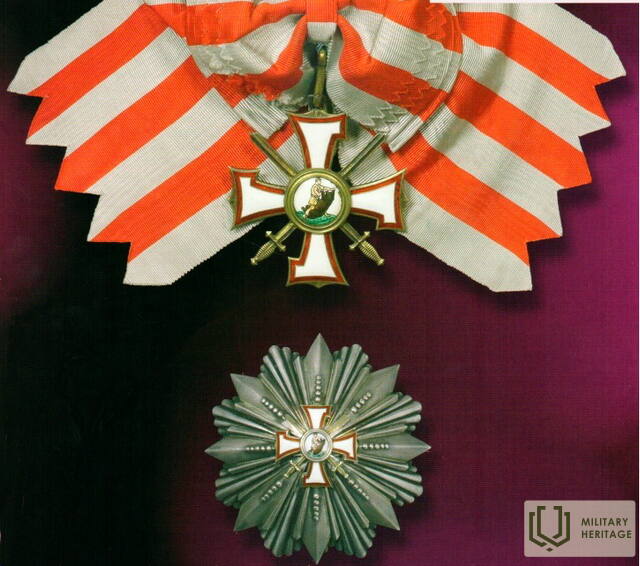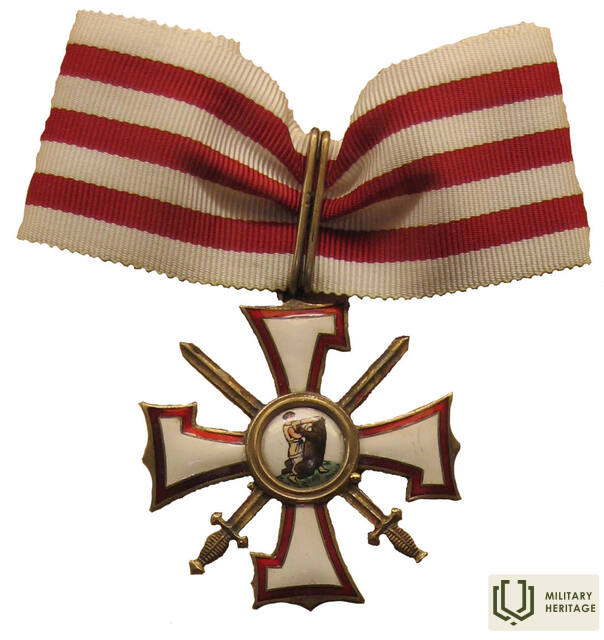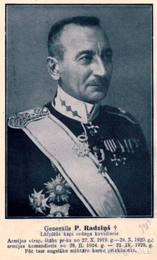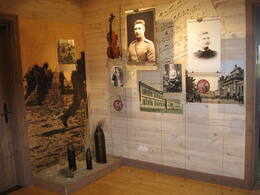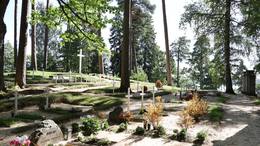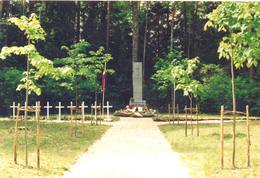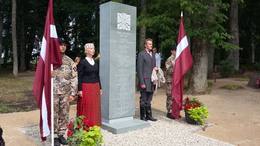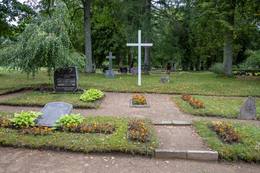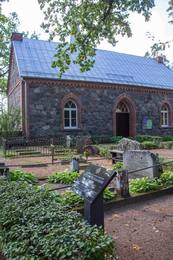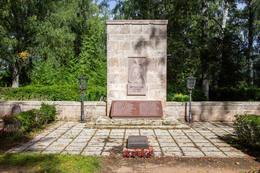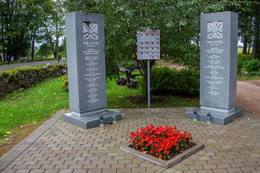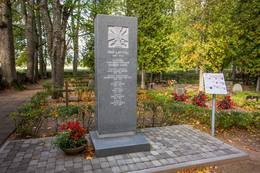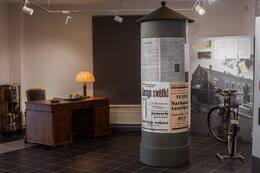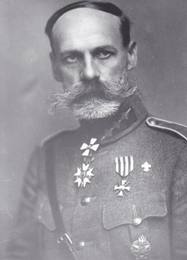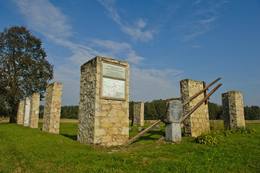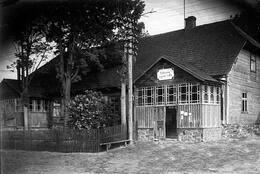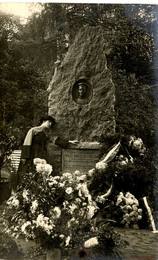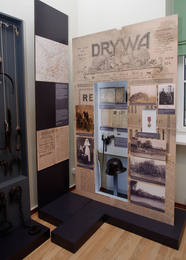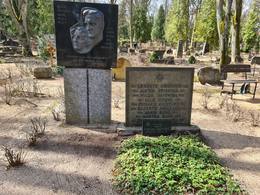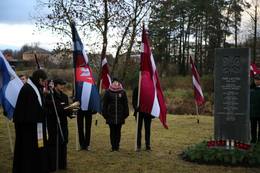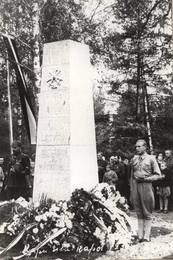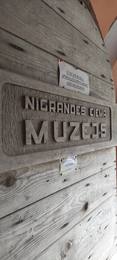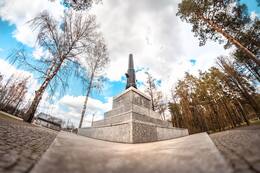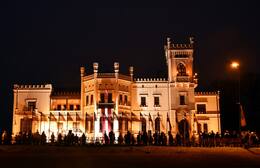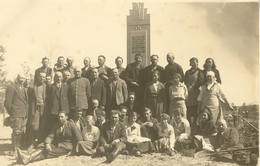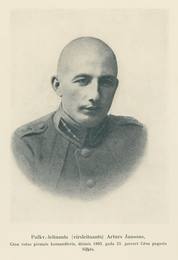Order of Lāčplēsis
I World War I, I Wars of Independence
The highest Latvian military award – the Lāčplēsis War Order – was established on 11 November 1919 in honour of the defeat of the Bermontites on the banks of the Daugava River and the liberation of Riga. The Lāčplēsis War Order also became the first Latvian state award. However, 11 November 1919 is the symbolic date of the order’s establishment, as the statutes of the order were approved by the Latvian Constitutional Assembly on 18 September 1920. The first award ceremony took place a year after the liberation of Torņakalns – on 11 November 1920 at the Esplanade. It was awarded to soldiers of the Latvian Army, former Latvian riflemen and foreigners, honouring their contribution to the struggle for Latvia’s independence. The first Lāčplēsis War Orders were received by: General Pēteris Radziņš, Colonels and Lieutenant Colonels Mārtiņš Peniķis, Krišjānis Berķis, Jūlijs Jansons, Jānis Apinis, Oskars Dankers and Jānis Puriņš.
The badge of the Lāčplēsis War Order is a white enameled fire cross with a red and gold border. On the obverse, the center medallion depicts Lāčplēsis fighting a bear. In the corners of the cross are crossed swords. On the reverse, the medallion contains the date “November 11, 1919”. The branches of the cross are engraved with “Par Latviju”, which is the motto of the order. The ends of the cross are engraved with the initials HB - the master mark of the silversmith Hermanis Banks. The order has a multi-rayed silver star, in the center of which is the badge of the order. A moire ribbon with three red and four silver stripes of equal width. The Lāčplēsis War Order has three classes - I, II and III classes.
The awarding of the Lāčplēsis War Order lasted until November 11, 1928. During these eight years, the Lāčplēsis War Order of the 1st class was awarded to 11 persons (4 Latvians and 11 foreigners), the Lāčplēsis War Order of the 2nd class - to 61 persons (18 Latvians and 43 foreigners), and the LKO Order of the 3rd class - to 2072 persons (1600 soldiers of the national army, 202 former Latvian riflemen and 271 foreigners). LKO cavaliers enjoyed a number of privileges - the right to wear a military uniform even after retirement, discounts on the purchase of railway tickets, the right to receive exemption from tuition fees for children in state schools, free medical care, etc.
A total of three women were awarded the Lāčplēsis War Order. One of them is the famous Latvian riflewoman Līna Čanka, whose life story has already become legendary. Born in 1895 in the "Mežzīlē" village of Renda parish, in 1915, as the German army approached, L. Čanka and her family left their home and went on the run. Having arrived in Riga, she made a decision that was unusual for the time - to fight against the invading army with weapons in their hands as part of the Latvian rifle battalions. Using the documents of her deceased brother Jānis and the favor of a guy she knew, who successfully passed the medical commission, L. Čanka managed to get into the 3rd Courland Latvian Rifle Battalion. However, very soon L. Čanka's fellow soldiers reported to the superiors about a rifleman with unusual behavior. When everything came to light, L. Čanka wanted to be expelled from the battalion, but she protested, expressed her desire to fight the enemy, and even threatened to shoot herself. As a result, L. Čanka was allowed to remain in the battalion.
More information sources
Sargs.lv. 2015. Latvian Riflemen — Cavaliers of the Lāčplēsis War Order. Available: https://www.sargs.lv/lv/vienibas-un-personibas/2015-11-23/latviesu-strelnieki-lacplesa-kara-ordena-kavalieri#lastcomment [accessed 06.05.2021].
Storm of Souls. Lāčplēsis War Order, 1919-1928. Available: https://www.dveseluputenis.lv/lv/laika-skala/notikums/124/lacplesa-kara-ordenis-1919-1928/ [accessed 06.05.2021].
Sargs.lv. 2011. Lāčplēsis War Order. Available: https://www.sargs.lv/lv/vesture/2011-04-18/lacplesa-kara-ordenis#lastcomment [accessed 06.05.2021].
Historia.lv. 2014. Lāčplēsis War Order. Available: https://www.historia.lv/biblioteka/skirklis/lacplesa-kara-ordenis [accessed 06.05.2021].
Related timeline
Related objects
Memorial site of General Pēteris Radziņš
Located in Valka parish, driving along the Valka – Rūjiena (P22) road at kilometer 4, turn right, following the signs.
Pēteris Radziņš was born on May 2, 1880 in “Jaunvīndedzēs” of Lugaži parish. He studied at Lugaži parish school, Valka city school and Valka Nelsons real school. He joined the Russian army as a volunteer. In the autumn of 1919, he returned to Latvia and on October 27, he was appointed Chief of Staff of the Supreme Commander of the Army, assuming this position at the moment when the Bermontites threatened Riga. As Chief of Staff, he led all the battles in Riga, Zemgale and Latgale. On February 5, 1920, he was promoted to general.
Nowadays, a memorial stone dedicated to General Pēteris Radziņš (1880 - 1930) can be seen near the family home.
On November 11, 2017, a memorial plaque to Pēteris Radziņš was unveiled in Riga, at the corner of Daugava Gate.
Video: General P. Radziņš memorial event at the Riga Brothers' Cemetery in 2019
Video: On May 2, 2019, on the 139th birthday of General Pēteris Radziņš, a commemorative event was held on the 11th November embankment, near the Presidential Palace, with an honor guard and interested parties surrounding the memorial plaque.
The Valka Museum of Local Lore's exposition "Valka - the Cradle of Latvian Independence" also reflects the life and activities of General Pēteris Radziņš.
In addition to traditional methods of displaying the collection, the exhibition uses interactive multimedia solutions. Information and annotations are translated into Estonian and English.
Oskars Kalpaks Museum and Memorial Site “Airītes”
The Oskars Kalpaks Museum and Memorial Site Airītes is located between Saldus and Skrunda near the A9 highway. The exhibit has extensive information about Colonel Oskars Kalpaks and his battalion, and shows the history of the Latvian National Army and the memorial site Airītes. The exhibit reveals Colonel Oskars Kalpaks as a personality, as a soldier and as a fighter for Latvia's independence. Audio logs in Latvian, English and German are also available as part of the exhibit. They emphasize the importance of the historic events of 1918/1919 in the protecting the statehood of Latvia. The museum building has been restored.
Entry is free; guided tour – for a fee. The complex has a recreation area, a park, an obstacle course, it is possible to take various classes, and there is a seminar hall for up to 30 people.
Alūksne Garrison Cemetery
Located on the shores of Lake Alūksne, on the Kapsētas Peninsula, in the territory of the Great Cemetery.
They began to be created and maintained with the care of soldiers of the 7th Sigulda Infantry Regiment in the 1930s and were consecrated on November 11, 1932. After the restoration of Latvia's independence, the care for the maintenance of the Garrison Cemetery, the identification of the resting places of the LKOK related to Alūksne, and the installation of memorial signs in the Garrison Cemetery was undertaken by Uldis Veldre, head of the Alūksne Brothers' Cemetery Committee department.
Military personnel of the Army of the Republic of Latvia are buried in the garrison cemetery, as well as soldiers and civilians who fell in the fight against the Bolsheviks on July 4, 1941 in Alūksne near Jāņkalniņš and on July 7, 1941 in Ziemers parish near the Prinduli houses.
Most of the burials have white wooden crosses with metal plaques that mention the name of the deceased, their rank or occupation, as well as their date of birth and death.
On December 19, 1990, a memorial plaque was unveiled at the Garrison Cemetery to the Cavalier of the Lāčplēsis War Order, Vilis Spandegs. Typical memorial plaques were also installed for LKOK who died or were murdered in communist concentration camps and were not buried in Latvia. On November 11, 1990, a memorial plaque was installed for LKOK Voldemārs Zaķis, who died in a communist concentration camp.
Karva Brothers Cemetery
Located on the side of the Alūksne - Ape road near Zuši mājas, south of Karva, at the turnoff to Rezakas.
The monument was unveiled on September 12, 1937. The granite stele was made at the O. Dambekalns stone quarry in Riga, after a design by the War Construction Administration architect Vemers Vitands.
In the autumn of 1975, local communists destroyed the monument. On March 30, 1989, the Alūksne District Council made a decision to restore the monument, and on April 30, 1989, a temporary wooden memorial in the form of a Latvian grave marker was installed in its place, made by Jānis Jaunzems, a worker at the State Electrical Factory (VEF). The inscription on it read: “The Karva Brothers Cemetery Monument will be restored here.”
At that time, the nearby Brothers' Cemetery was also improved.
In 1993, thanks to the initiative of Ulda Veldre, head of the Alūksne Brothers' Cemetery Committee, the restoration work of the memorial site resumed. The new monument was made by the Cēsis stonemason brothers Aivars, Austris and Auseklis Kerliņi.
The monument was unveiled on June 11, 1994.
Four soldiers of the 5th company of the Valmiera Infantry Regiment are buried in the fraternal cemetery - Jēkabs Sukse, Pēteris Leitlands, Ernests Puķītis and Gustavs Ozols, who fell in the battles near Zuši on April 2, 1919. The fifth soldier buried in the mid-1930s was Roberts Glazners, a soldier of the Valmiera Regiment who disappeared without a trace on March 31, 1919 near Jaunā muiža. Initially, he was buried as an unknown, but later his name was clarified and engraved on a monument. In turn, the fifth soldier who fell in the Battle of Zuši, Augusts Dzedons (Ziedons), is buried in the Apekalna cemetery.
A memorial plaque has been installed at the foot of the monument to Jānis Goldes (1891–1952), a participant in the Battle of Eels, who died in the communist concentration camp in Inta, Komi.
The second memorial plaque, unveiled on August 23, 1992, is installed near one of the wooden crosses and is dedicated to Corporal Pēteris Jansons of the 7th Sigulda Infantry Regiment, who was murdered by the departing communists on July 7, 1941.
Monument to the participants and fallen of the War of Independence
Located in the Center Cemetery, Barkava parish, Madona region.
Near Barkava St. Stanislaus Roman Catholic Church.
A monument to the participants and fallen of the Latvian War of Independence is on display. The monument was unveiled on November 11, 2018. It was created at the initiative of Janīna Liepiņa, a history teacher at Barkava Elementary School.
It is made of black, polished granite and consists of a cross, to which two memorial plaques are attached on both sides, on which are engraved the names of 47 local residents who participated in the Latvian War of Independence, fell in it or received the Lāčplēsis War Order, as well as the names of those from Barka who were murdered by the Bolsheviks.
Nearby you can see: a monument to the soldier Jezupas Reidzāns who fell in the War of Independence and a monument to Aleksandrs Lakstīgals, a soldier of the 1st Liepāja Infantry Regiment.
The monument to Aleksandrs Lakstigals was unveiled on August 30, 1936. It was unveiled by the commander of the 17th Rēzekne Guards Regiment, Zarāns.
The monument to the soldier of the 1st Liepaja Infantry Regiment was erected by the 10th Company of the 17th Rēzekne Guard Regiment with donated funds.
Memorial stele for the Cavaliers of the Lāčplēsis Military Order
Located in Matīši Cemetery, Matīši Parish.
The memorial stele contains the names of 15 knights of the Lāčplēsis War Order, who are associated with Matīši, as well as the neighboring Vilzēni and Braslava parishes, which were once united by the Matīši church congregation. Those who died abroad or were buried in other places in Latvia, but here in Matīši there is a family cemetery, were also identified.
The memorial stele was unveiled on August 4, 2018 in honor of Latvia's centenary.
The Lāčplēsis War Order (LKO) was the highest military decoration of Latvia from 1920 to 1940. The LKO was awarded for combat merit to soldiers of the Latvian Army and former Latvian Riflemen Regiments, as well as to foreigners who had made a great contribution to the Latvian freedom struggle or otherwise contributed to the establishment of the Latvian state. The LKO motto is "For Latvia", and it has 3 classes. The first class, which is awarded only to high-ranking statesmen and generals.
Burials of Latvian legionnaires and those who fell in the War of Independence
Located in the Cesvaine Ķinderu cemetery.
A granite memorial stone to Latvian legionnaires, unveiled in June 1997 at the fraternal cemetery, can be viewed, and individual burials of those who fell in the War of Independence can be found and viewed.
An information board with a diagram of the memorials and burial places of the fallen has been installed at the cemetery:
1. Cemetery of Latvian legionnaires 1943-1945.
2. Jēkabs Markovs 08.02.1883-08.08.1917. Rifleman of the 8th Valmiera Latvian Regiment
3. Arvīds Alberts Strads, commander of the “Green” partisans, 22.09.1894.-05.04.1919. First Lieutenant
4. Harijas Lezons 18.03.1914.-19.01.2003. Captain
5. Jānis Purēns 15.11.1887 - 18.11.1918. Cavalier of the Lāčplēsis War Order.
Burials of the Cavaliers of the Lāčplēsis Military Order at Palsmane Cemetery
Located in Palsmane Cemetery.
The burials of 7 knights of the Lāčplēsis Military Order can be viewed.
Thanks to the project “Digitalization of Palsmane Cemetery”, visitors can find the burial places of the knights of the Lāčplēsis Military Order:
Individual burial of LKOK Rūdolfs Beitiks
Individual burial of LKOK Kārlis Brītiņš
Individual burial of LKOK Roberts Kukurītis
Individual burials of brothers LKOK Jūlijas Zīle and LKOK Rihards Zīle
Individual burial of Ernests Lielmanis, member of the Lithuanian Orthodox Church
Individual burial of LKOK Pēteris Rabacs
Individual burials are marked with a star on the map .
In 2019, in honor of the 100th anniversary of the founding of the Lāčplēsis War Order, as well as to honor the soldiers of the region who have been awarded the Lāčplēsis War Order, on November 11, the memorial sites created at the Palsmane Cemetery were ceremonially opened.
Memorial signs and information stands about the LKO cavaliers of the region have been placed.
Monument to the memory of the people of Smilteni who fell in the War of Independence
Located in the Smiltene Lutheran Cemetery at 11 Vaļņu Street.
The monument in memory of the people of Smilteni who fell in the War of Independence was opened and consecrated on November 7, 1937. The monument is built of concrete and covered with Allaži travertine slabs. The monument was designed by architect Verners Witands and sculptor Matīss Plukas.
In front of the monument, on October 31, 1937, the remains of Lieutenant Pēteris Krievs, a Cavalier of the Lāčplēsis War Order who fell in the Battle of Airītē on March 6, 1919, were reburied from the family grave. On November 7, 1937, a black granite memorial plaque was placed at his grave.
Several fallen Latvian riflemen and Latvian army soldiers who fell in the War of Independence are buried in the cemetery. In the Smiltene Evangelical Lutheran Church, on both sides of the altar, on October 2, 1927, dean Kārlis Kundziņš consecrated 2 white marble memorial plaques.
Memorial sites of generals and knights of the Lāčplēsis Military Order in Trikāta parish
The memorial stele is located next to the Trikāta cemetery chapel.
The Trikāta cemetery preserves the memory of three outstanding Latvian generals - Roberts Dambītis, Kārlis Goppers and Jānis Balodis. The teacher of all these generals, Jēkabs Mūrnieks, is also buried in the Trikāta cemetery, for whom a monument made of travertine, modeled after Kārlis Zāle, was erected at the burial site in 1928.
The generals and knights of the Lāčplēsis Military Order are commemorated every year with torchlight processions to the Trikāta cemetery, where there are two memorial steles, in which a total of 17 names of knights of the Lāčplēsis Military Order associated with the Trikāta parish are engraved.
The stele was unveiled on November 11, 2018.
Video about the Lāčplēsis War Order and a set of orders that belonged to General Jānis Balodis.
Memorial stele for the Cavaliers of the Lāčplēsis Military Order
Located next to the Kauguri cemetery chapel.
A memorial stele and an information stand with the biography of each knight of the Lāčplēsis War Order, places of battle and resting place can be viewed.
The text inscribed on the stele is somewhat misleading, as only two LKOK are buried in the Kauguri cemetery – A. Ābeltiņš and Ē. Radziņš, while the others mentioned on the stele are connected to Kauguri parish in other ways – either they were born there or lived there for some time.
The Lāčplēsis War Order (LKO) was the highest military decoration of Latvia from 1920 to 1940. The LKO was awarded for combat merit to soldiers of the Latvian Army and former Latvian Riflemen Regiments, as well as to foreigners who had made a great contribution to the Latvian freedom struggle or otherwise contributed to the establishment of the Latvian state. The LKO motto is "For Latvia", and it has 3 classes. The first class, which is awarded only to high-ranking statesmen and generals.
The stele was unveiled on November 11, 2018.
Exhibition "Latvian Army in Pļaviņas in the 20th Century."
Located at Odzienas Street 2, Pļaviņas.
The permanent exhibition "Latvian Army in Pļaviņas in the 20th Century" is on display.
The building in Pļaviņas, at Odzienas Street 2, has a long history – from the time when the Stukmaņi wholesaler Hugo Apeltofts began active economic activity there, thus contributing to the development of the city of Pļaviņas, to the moment when the headquarters of the Latvian Eastern Front was established here during the War of Independence. In 1919, it was from Pļaviņas that the operations of Latvian army units against the Red Army in Latgale were led.
In 1934, a memorial plaque was unveiled near this house with the inscription: “In 1919, the Eastern Front headquarters was located in this house, and here General Jānis Balodis assumed the supreme command of the Latvian National Army.” The Soviet government removed and destroyed it in 1940, but on June 16, 1990, with the support of the Pļaviņa branch of the Latvian National Liberation Army, it was restored.
Now, near the former headquarters building, there is a memorial stele dedicated to the 15 knights of the Lāčplēsis War Order born in the Pļaviņa region, and an exhibition "The Latvian Army in Pļaviņa in the 20th Century" has been created inside the premises, which tells about the events during the Freedom Struggles, the activities of the headquarters of the 3rd Latgale Division of the Latvian Army in Pļaviņa, and also provides an insight into the life stories of the knights of the Lāčplēsis War Order.
Not far from the exhibition building is the Latgale Division Headquarters building, which was built in 1913 as the Stukmanu liqueur factory by Count Teodors Medem. In 1919, it was taken over by the P. Stučka regime, where it had also established a prison. After the Bolsheviks were expelled, the building was taken over by the Latvian Army in 1925, which housed the Latgale Division Headquarters. 10 generals and other officers of the Latvian Army spent their military careers in this building. In 1940, the building was taken over by the Red Army. In the post-war years, it housed a school, as well as the municipality. Around 1970, the building began to be used by the production association “Rīgas Apērbs”.
Visiting the exhibition must be booked in advance by calling T. 28442692.
General Karls Goppers Memorial Room in his birthplace "Maskati"
Located in Plāņi parish on the banks of the Vija River.
The memorial room of General Kārlis Goppers in his birthplace "Maskati" can be visited.
The “Maskatu” farm was run by the general’s brother Augusts Goppers, because the talented war leader was busy with major events and world wars. In 1920, the general returned to Latvia, to his native home. But many responsible duties connected him to Riga. Augusts continued to manage “Maskatu”. In 1940, General Goppers was arrested and shot in the Cheka cellars on March 25, 1941. In 1944, the Gopper family fled to Courland with three horse-drawn carriages. The war divided the family, and Aleksandrs Goppers’ daughters – Biruta, Elza and Anna – remained in Latvia. They were no longer allowed to return to “Maskatu”. The houses were large and carefully maintained. Three or four families of newcomers were accommodated there in separate rooms. A horse farm was set up in the large barn. Due to mutual quarrels, a fire broke out in 1980. The barn and the large shed burned down. Fortunately, the fire did not spread to the house, the flames were repelled by large trees planted by our ancestors.
In 1991, after the miraculous Awakening, the Latvian state was reborn for the second time. In 1992, the family of General Goppers' brother August regained “Maskatus” as a sacred place of their ancestors. For ten years, everyone worked hard to save the houses from destruction, to restore and rebuild the destroyed buildings, to make the entire “Maskatus” farm beautiful. The houses have been restored to their ancient appearance, and a memorial room for General Kārlis Goppers has also been set up. The memorial room can be visited by calling in advance and making an appointment at +371 29396870, +371 29254285.
Memorial site for the victims of communist terror in Jaunrauna parish
Located in "Baižēni", Priekuli parish
A memorial site for the repressed was established on the site of the ruins of the “Baižēni” house barn, where 40 residents of Jaunrauna parish were held on the night of March 25, 1949, so that in the morning their path would lead them further to the Lode railway station and Siberia.
Among those repressed were children under the age of 1 and 87-year-olds.
The memorial plaque also contains the names of those who were shot or died in exile. Nearby are memorial stones for the cavaliers of the Lāčplēsis War Order.
Lubāna Municipality tourism and cultural heritage centre
The Lubāna Municipality Tourism and Cultural Heritage Centre is located in the very centre of the city of Lubāna. It features several exhibits, including permanent ones, on the history, culture and traditions of and events at the municipality. The permanent exhibits are dedicated to personalities that Lubāna is especially proud of. They introduce poet Broņislava Martuževa, member of the National Resistance Movement and political prisoner; politician Hugo Celmiņš, a participant of the War of Independence; Oskars Kalpaks, First Commander-in-Chief of the Latvian Army; photographer Alfreds Grāvers; opera singer Jānis Zābers; poet Jānis Gavars; artist Rūdolfs Pinnis, as well as folklorist and pastor Mārtiņš Celmiņš. A guide describes the lives of the Knights of the Lāčplēsis War Order and freedom fighters in Lubāna and its adjacent territory, as well as their resting places in Lubāna’s old graveyard. Available languages: Latvian and Russian. Guided tours with a German and English translation can be booked in advance.
Monument to the soldiers who fell in the War of Independence
Located in Valka on Varoņu Street next to the Forest Cemetery.
A monument to 30 soldiers of the 1st (4th) Valmiera Infantry Regiment who fell in the Latvian War of Independence can be seen.
The monument was unveiled on October 1, 1922. It consists of a figure of an ancient Latvian warrior (“Ancestor”) carved from local reddish granite, placed on a two-part pedestal made of gray granite. The design chosen for the monument was by sculptor Emīls Melders (Miller). Along with Melders, sculptor Vilhelms Treijs also participated in the carving of the monument.
It is the first monument to the Latvian War of Independence created by a professional sculptor, as well as the only one in the interwar period made in the modernist style, using cubist elements.
During the repeated communist occupation in 1951, the monument sculpture was toppled, partially damaged, and buried. The burial grounds were also leveled.
In 1988, as the centenary of the sculptor E. Melders (1889-1979) approached, a study of his works was initiated.
The restored fraternal cemetery, along with the restored monument, was opened on November 11, 1990.
In 2017, eight memorial steles were installed at the fraternal cemetery to the knights of the Lāčplēsis War Order associated with Valkas. They are located on both sides of the monument – four steles on each side.
Monument to Naval Lieutenant, L.k.o.k. Vilis Gelbes (1890-1919)
Located at the Limbaži Jūras Street Cemetery, Jūras Street 56, Limbaži
On display is a monument unveiled on September 10, 1922 by the then President of Latvia, Jānis Čakste, which contains the dedication of the poet Vilis Plūdonis to Vilis Gelb:
"My people, who pass by me, burn with love for your fatherland,
"For the sake of my beloved fatherland, I pledge my life."
Vilis Gelbe (1890-1919) was born in Courland, in Zemīte parish, but was also closely connected to the Limbaži side, because when the Latvian War of Independence began, he returned to Latvia from St. Petersburg and joined the North Latvian Brigade.
In May 1919, V. Gelbi commanded in Limbaži, he became the military commandant of the area and was able to inspire the local men and even very young boys to join the army.
V. Gelbe's activities in Limbaži and its surroundings at that time were very significant; his duties included not only maintaining order in the city and its surroundings, but also mobilization, providing food for soldiers and horses, and resolving many other issues that could not be included in orders and instructions. The commandant's team organized by him acted as a coordinated mechanism to provide the North Latvian Brigade with the most effective assistance possible. The commandant's team went to the aid of the regular army in special cases, and he set an example for the new soldiers. V. Gelbe was the first officer of the Latvian army who proposed awarding his subordinates with the Order of Imanta, Class III. The order did not yet exist. The name of Imanta appeared in public only on March 20, 1920, when a presentation on the establishment of a military order was submitted to the Minister of Security, Kārlis Ulmanis. However, the name of Lāčplēsis was chosen for the order.
During the Battle of Cēsis, Vilis Gelbe died - on June 19, 1919, during a reconnaissance mission. Gelbe was later awarded the Lāčplēsis War Order, but historians believe that his contribution has not been properly appreciated. This is mainly due to Gelbe's membership in the North Latvian Brigade.
The so-called Southern Latvian Brigade, initially commanded by Oskars Kaplaks and later by Jānis Baložs, competed with the Northern Latvian Brigade, commanded by Jorģis Zemitāns.
A memorial in Vidriži at the place where LKOK Vilis Gelbe and two soldiers from his team fell.
In Vidriži, at the turnoff to Lēdurga, during the War of Independence on June 19, 1919, naval lieutenant Vilis Gelbe and two soldiers fell in battle.
Vilis Gelbe was buried in the Limbaži cemetery. For his heroic deed near the Vidriži manor, Vilis Gelbe was awarded the Lāčplēsis War Order, 3rd class (No. 895).
Currently, three Pemin crosses, installed in 1989, can be seen at the battle site.
On June 22, 1934, a bronze memorial plaque modeled after the artist Stefans Bercs was unveiled near the maple tree growing in the manor park. Already at the beginning of the communist occupation in the autumn of 1940, the memorial plaque disappeared. The maple tree to which it was nailed also perished. When the Awakening began, on June 19, 1989, on the 70th anniversary of the death of Gelbe and two soldiers from his team – Corporal Krustiņš and Private Krūze – at the crossroads where the memorial plaque once stood, at the initiative of the Environmental Protection Club and the Limbaži district branches of the Latvian Popular Front, three wooden crosses made in the folk style by Jānis Eglītis were installed. By decision of the Limbaži district executive committee in April 1991, this memorial site was included in the list of historical monuments of local importance.
Preiļi Museum of History and Applied Arts exhibition "Museum Stories for Latvia"
Located in the premises of the Preiļi Cultural Center.
The Preiļi Museum of History and Applied Arts (PVLMM) exhibition "Museum Stories for Latvia" about the First World War, the War of Independence and the Second World War is on display.
The section "The Story of Drywys" of the Preili History and Applied Arts Museum's exposition "Museum Stories for Latvia" (opened in 2018) is dedicated to the First World War, the War of Independence and the liberation of Latgale, as well as the Cavaliers of the Lāčplēšana War Order. The section of the exposition "The Story of the Flag" tells about the complex events of the Second World War, during which the people of Preili were affected by deportations, the Holocaust, involvement in the military units of the warring parties, and after the war - in the ranks of the national partisans. The medal "Righteous Among Nations" awarded to the Preili resident and Jewish rescuer Vladislavs Vuškāns is also on display.
Tours are available in Russian and English by prior arrangement.
Monument to the first fallen soldier of the School Company, Edgars Krieviņš
Located in the Valmiera City Center Cemetery, near the chapel (Miera Street 1/3, Valmiera)
A soldier of the 8th (Student) Company of the Cēsis Regiment, LKOK Edgars Krieviņš (1899-1919), died on June 7 from injuries sustained in the Battle of Cēsis on June 6, 1919, when, when the enemy attacked, he covered the retreat of the rest of the units.
Memorial stele to the Cavaliers of the Lāčplēsis War Order
Located next to the Sacred Heart of Jesus Roman Catholic Church in Viļaka.
A memorial stele for the cavaliers of the Lāčplēsis War Order in Viļaka municipality was unveiled on November 11, 2017. The fates of 28 cavaliers of the Lāčplēsis War Order are linked to the name of Viļaka municipality.
The granite stele was created as part of the project “Remember Lāčplēšis” dedicated to the centenary of the state of Latvia. In honor of the soldiers who fell in the Latvian War of Independence, memorial stele of a uniform model will be installed throughout Latvia. The initiator of the project is the Youth Guard and Information Center.
Five knights of the Lāčplēsis War Order, whose names are engraved on the memorial stele, lived in the territory of the present-day Viļaka district after the end of the War of Independence:
– Jānis Kuļšs was a young farmer in Apsīši, Šķilbēni parish,
– Aleksejs Ľubimovs (Lavrentjevs) lived on the Fortepjanova farm in Šķilbēni parish, later in Viļakas,
– Teodors Mende managed the farm assigned to him and was a forester in the village of Katleši, Žīguri parish,
– Eduards Tenisons lived at the Vecumu station, later lived in the village of Čabatrova and worked at the “Viļaka” post office,
– Jānis Burmeistars lived in Šķilbēni parish for some time after 1928.
The Brothers' Cemetery in Viļaka district is the resting place of 45 soldiers who gave their lives defending Latvia from the Bolsheviks in 1920. January 9 was the day when the attacks began in Northern Latgale, and despite the difficult weather conditions at the time, Viļaka was liberated on the same day.
During the battles for the liberation of Latgale in the Viļaka region, Estonian soldiers fought shoulder to shoulder with Latvian army soldiers and partisans against the Red Army. Many of them gave their lives for a free Latvia.
Barn of Nygrande Manor
The Nīgrande Local History Repository is located in the Nīgrande village in the manor barn, next to the Nīgrande Primary School, and is accessible by appointment.
The military history section of the repository includes an exhibition on World War II and original objects and parts found in the area after the war and in later years. You can also find out stories and see photographs about Nygrande and its surroundings from the War of Independence, World War II and the post-war period, as well as life on the collective farm in Soviet times.
The exhibition has a special place for the local writer Jēkab Janševskis and his works, and there is an exhibition presenting traditional manor house life and furnishings. A mammoth tusk found in Nīgrande is also on display in the barn of Nīgrande Manor.
Livani Liberation Monument
The monument is located at the intersection of Fabrikas and Stacijas streets, where it was unveiled on June 9, 1935 by General Rūdolfs Bangerskis, honoring the memory of the soldiers who fell in the battles for the liberation of Līvāni in 1919.
Its main element is a 15-ton, vertically placed cannon barrel. In 1958, the Soviet government dismantled the symbol of freedom in Līvāni, cutting the cannon barrel into scrap metal. The residents preserved the cannonballs throughout the Soviet years, and they returned to their previous location after half a century. The idea of restoring the monument was alive among the people all these years. The Līvāni County Council, together with the residents, actively worked on the restoration of the monument. Donations were collected from the people, and on October 3, 2004, the restored Līvāni Liberation Monument was unveiled in its historical place in the city park.
Inscription on the monument: “Soldiers of the Jelgava Infantry Regiment who fell for Latvia near Līvāni and the liberation of the surrounding area in 1919. Soldiers of the former Northern Latvian Partisan Regiment.”
The names of soldiers and partisans follow.
Memorial plaques for the cavaliers of the Lāčplēsis War Order in Līvāni district have been installed nearby.
The author of the monument's design was architect Pāvils Dreimanis.
October 3–5, 1919. Battle of Līvāni
On October 3, 1919, the Bolsheviks received a strong blow on the front near Līvāni. Units of the 3rd Jelgava and 4th Valmiera Infantry Regiments, as well as units of the Latvian German Landeswehr (former Landeswehr), participated in the attack on Līvāni. With artillery support, units of the 3rd Jelgava Infantry Regiment moved across the Daugava. After the successful move, the battle for Līvāni began, which lasted all day long. At around 17:30, Līvāni station was captured, and an hour later the bridges over the Dubna River were crossed. The combined forces managed to drive the Bolsheviks out of Līvāni, and by 19:00 the city was completely liberated. On October 5, 1919, the Bolsheviks tried to regain Līvāni by attacking the new positions of the 3rd Jelgava and 4th Valmiera Infantry Regiments. The Latvians held the occupied positions with difficulty. This was the first serious and successful attack on the Eastern Front between July and October 1919.
While at the Līvāni Liberation Monument, you can scan the QR code and listen to an audio story about the history of the monument. The story is also available on the IziTravel platform HERE . The story is available in Latvian and English.
Alūksne Museum
The Alūksne Museum is located in an architectural monument of national significance: the neo-Gothic Alūksne New Castle built in the late 19th century. The museum features an exhibition named ‘Memorial Room for Victims of the Totalitarian Regime’, which tells about the fate of the inhabitants of Alūksne municipality in Siberia and the Far East, while the time periods from prehistory to the present meet in the Alūksne history exhibit ‘Feast of the Ages’. It features a separate section devoted to the contribution of the 7th Sigulda Infantry Regiment to the military, culture and public life. The formation of the 7th Sigulda Infantry Regiment began on 20 June 1919 in the Naukšēni Manor. Initially, a battle group of 22 officers and 1,580 soldiers was formed from the reserve battalion of the Northern Latvian Brigade, and was named the Dankers Division. It was included in the 2nd Battalion of the 3rd Jelgava Regiment. On 23 August, following an increase in the number of companies, it became part of the 7th Sigulda Infantry Regiment. Having taken part in the battles against Bermondt, on 5 January 1920, the regiment was transferred to the Latgale front to fight the Bolsheviks. After the signing of the Peace Treaty with Soviet Russia, the regiment guarded Latvia’s eastern border. The Latvian War of Independence saw the deaths of more than 200 soldiers of the regiment, while 85 were awarded the Lāčplēsis War Order. In 1921, the 7th Sigulda Infantry Regiment was stationed in Alūksne. The regiment’s headquarters were set up in the Alūksne New Castle. After World War II, the castle was taken over by Soviet security institutions. As of the late 1950s, the castle housed various cultural institutions: the Culture and Cinematography Department of the Executive Committee, a pioneer house, a library, a cinema and a museum.
Monument to the soldiers of Anna Parish who fell in World War I and the Latvian Liberation War
Located in the central part of the Ezeriņi cemetery in Anna parish.
In the cemetery, where burials have been held since 1925, there is a monument erected with funds collected by the Annas parish Guards Department and opened in 1933 to the soldiers of Annas parish who fell in World War I and the Latvian Liberation War. Until World War II, the Annas parish guards took care of the maintenance of the monument, who went to the cemetery every Sunday and, honoring the fallen, laid flowers. On November 18, 1940, the monument was shot down, the traces left by the bullets are still visible. Nowadays, commemorative events dedicated to Lāčplēsis Day are held in the cemetery every year.
In 2004, a memorial site was opened in the cemetery for those politically repressed in 1941 and 1949, and in 2006, a memorial plaque was opened for national partisans.
Monument at the site of the first battle of the Cēsis Company
Located in Drabeši parish, at kilometer 79 of the Vidzeme highway.
A monument made of granite is visible, with a stylized diagram of the Bolshevik invasion route carved into it.
The monument was unveiled and consecrated on December 28, 2018. In Drabeši parish, on December 24, 1918, the reconnaissance team of Captain Artūrs Jansons (1893 - 1941) delayed the advance of Red Army reconnaissance from Cēsis to Ieriķi with heavy machine gun fire. It was the first armed clash of Latvian troops with the Red Army of Soviet Russia.
Misiņkalns Military Heritage Trail
Misiņkalns nature park is located in the town of Aizpute. Misiņkalns is the highest place in the city of Aizpute. Its height reaches 95.4 m. The top offers a scenic view of the city. Misiņkalns nature park was started to be built in the 20th century. at first. The area of the park is currently about 28 ha.
In the territory of the park there are several places and memorials related to the events of the 20th century - the memorial stele of the soldiers who died in the Latvian Freedom Wars - the cavaliers of the Lāčpleš Order, the place of the Holocaust memorial, the place of remembrance of the repressed and the memorial plaque of the fallen red partisans.
In the park, you can get to know the plants and plantations of various rare species, as well as enjoy the untouched nature. Currently, the park is criss-crossed by renovated walking and cycling paths, and there is a motorcycle track on the territory of the park, where Latvian motocross competitions take place.
In order to get to know the cultural and historical heritage of Misiņkalns manor park more fully, we recommend using the services of a guide.
Steles in memory of the knights of the Lāčplēsis War Orders
Twenty-seven knights of the Lāčplēsis Military Order are associated with the Aizpute region.
Honoring the soldiers who fell in the Latvian War of Independence, memorial steles of a uniform model were installed throughout Latvia, in which the font of the text engraving corresponds to the standard of the heroes' memorial plaques, which is analogous to the engraving of the sandstone memorial signs of the Riga Brothers' Cemetery and the Central Cemetery Field.
The granite steles were created as part of the Young Guard and Information Center project “Remember Lāčplēšis” dedicated to the centenary of the state of Latvia.
Stele "To the Heroes of the War of Independence" in Jaunjelgava
A memorial plaque is dedicated to the knights of the Lāčplēsis War Order born in the Jaunjelgava region. The stele was unveiled on November 2, 2017. The names and years of life of the knights of the Lāčplēsis Order who came from the specific region are engraved on the approximately two-meter-high memorial plaque. On the other side of the stele is the text: “To the Heroes of the Latvian Freedom Struggle on the Centenary of Latvia”
"The installation of such standard memorial signs dedicated to the heroes of the Latvian War of Independence of 1918-1920 in all regions of Latvia is taking place in accordance with the project "Remember the Lāčplēšis", which was initiated last year by the Information Center of the Ministry of Defence and the Young Guard. The approximately two-meter-high memorial stele was created from gray Finnish granite after a design by artist Jānis Strupulis.
Memorial site of General K. Berkis
A monument to General Krišjānis Berķis (1884 - 1942) was erected on the site of his birthplace near an oak tree. The monument was erected by the Latvian National Soldiers' Association at its own expense on April 26, 1998. Kr. Berķis was a general of the Latvian Army, commander of the Latvian Riflemen, fought in World War I and the Latvian War of Independence. Cavalier of the Lāčplēsis War and Three Star Orders. Commander of the Latvian Armed Forces, Minister of War of Latvia.
Krišjānis Berķis was born on April 26, 1884 in Bērzukrog, Īslīce parish. In 1903, after graduating from Bauska city school, Kr. Berķis entered the Vilnius Junkers School, which he graduated after 3 years as a sub-lieutenant. He served in the 2nd Finnish Rifle Regiment in Helsinki. In 1909, Kr. Berķis received the rank of lieutenant, in 1913 – staff captain, and in January 1917 – captain. In July 1917, Kr. Berķis received the rank of lieutenant colonel and became the battalion commander of the 6th Tukums Latvian Rifle Regiment. After the October Revolution, Kr. Berķis was removed from office and imprisoned for a short time, but after his release he was still forced to hide from the Bolsheviks in both Finland and Russia, until finally returning to Latvia in the spring of 1919. On March 21, 1919, Kr. Berķis, already as a colonel - lieutenant, joined the armed forces of the Provisional Government of Latvia and became a commander of a reserve battalion (later the 2nd Cēsis Infantry Regiment), and from August - the commander of the Latgale Division. In October 1919, Kr. Berķis received the rank of colonel. In April 1920, Kr. Berķis was elected a deputy of the Constituent Assembly, but he refused the mandate. In 1925, Kr. Berķis was awarded the rank of general. Until 1934, he worked in the Administrative Department of the Army Headquarters, was the commander of the Vidzeme Division and the chief of the Riga garrison. In November 1934, Kr. Berķis was appointed commander of the army, and on April 5, 1940 - the minister of war. On June 20, 1940, Kr. Berķi was discharged from service, arrested in July, and on August 9, together with his son and daughter-in-law, was deported to Russia, where he was imprisoned in June 1941. He died on July 29, 1942, in the Perm prison hospital.
Related stories
Liberation of Northern Latgale from the Bolsheviks
On December 1, 1918, the Red Army units, based on the Red Riflemen units, invaded the territory of Latvia. In order to protect their homes, families, native region and escape from terror, the men of the Balvi area took up arms and went into the forests, the formation of the first “green” groups began. In the spring of 1919, when mobilization was announced, many men of the Balvi area found fighting in the Soviet Latvian Army unacceptable and joined the “green” groups. The Balvi, Silakrogs, Rugāji, Teteru-Dūrupe and Liepna groups were formed. The activities of the “green” groups in the Balvi area became more active in March 1919.
About the national patriot First Lieutenant Vili Gelbi
The fate of Lieutenant Colonel Vilis Gelbe (1890-1919) reflects the difficult situation in the formation of our state and army, as well as the assessment of these events.
With the proclamation of the Latvian state on November 18, 1918, the Latvian War of Independence and the work of building the armed forces began. In the first ranks of the Latvian volunteer soldiers was the naval lieutenant Vilis Gelbe, who was born in Courland.
About the first Commander-in-Chief of the Latvian Army, Dāvids Sīmansons
The essays in the book "Commanders of the Latvian Army" convince us that history is significantly influenced by specific individuals. Although they were at the epicenter of the most important historical events for a short time, true Latvian patriots, with their rich military experience, managed to do a lot in the formation and strengthening of the Latvian army and in the turning points of historical events.
This story is about the first Commander-in-Chief of the Latvian Army, Dāvids Sīmansons (1859-1933).
7th Sigulda Infantry Regiment's Bermontiad Battle, awarding of Grand Duchess Valija Veščūna with the Lāčplēsis War Order in Alūksne
After the Latvian War of Independence, Grand Sergeant Valija Veščunas was awarded the Lāčplēsis War Order for the battles with the Bermontites near the Plāņi houses on November 19, 1919. Valija Veščunas was one of the first to cross the Lielupe River under enemy fire.
A moment of remembrance at the Garrison Cemetery
After the restoration of Latvia's independence, Uldis Veldre, head of the Alūksne Brothers' Cemetery Committee, took on the responsibility for maintaining the Garrison Cemetery, identifying the resting places of the LKOK related to Alūksne, and installing memorial signs in the Garrison Cemetery.
About General Karlis Goppers
General K. Goppers (1876-1941) was an outstanding soldier and an outstanding person. He distinguished himself as a successful commander who took command of battalions and regiments, heroically leading his riflemen in battles for the freedom of Latvia during the First World War (1914-1919). He participated in the battles at Tīreļpurva, Ložmetējkalns, and in the defense of Riga.
The life of General Jānis Baložs after his return from exile
When in 1940 the Russians tried to squeeze a favorable military base agreement from the Latvian government, which would make the Latvian army's ability to resist the Red Army almost impossible, General J. Balodis tried to get some amendments to the agreement. However, this did not work. But the general's detractors used this circumstance to later make J. Balodis almost a traitor. After a conflict with the Prime Minister and State Minister K. Ulmanis, the general was dismissed from the post of Minister of War on April 5, 1940. Then J. Balodis decided to participate in the Saeima elections from the Democratic Bloc, but nothing came of it, because only one list was allowed to run in the elections - the list of communist candidates. Latvia became the 14th Soviet republic.
In memory of Pēteris Radziņš, general of the Latvian Army, two-time Cavalier of the Lāčplēsis War Order
General Pēteris Radziņš was born in Lugaži parish, Valka district, into a simple farmer's family, where he learned to do field work. He was a very smart young man, after graduating from school he decided in favor of war and thus began his army career, saving Latvia from Bermont's troops. P. Radziņš was one of the most outstanding officers of the Latvian army and was awarded numerous Latvian and foreign orders and commemorative signs.
Aizporis Manor during the War of Independence
Aizporu Half Manor, Aizpute district, Kalvene municipality, is the westernmost place in Latvia to which Colonel Oskars Kalpaks' separate battalion retreated.
Halfway between Rudbārži and Kalvenė, on the side of the road, is the Aizpore cemetery. There is a monument and 12 memorials to the volunteer soldiers of Oskars Kalpaka's battalion.
Historical evidence in the Līči – Laņģi cliffs
Fragments from local history enthusiast Aivars Viļnis's story about history and its evidence found in Lode and Liepa, in what is now Cēsis municipality.




